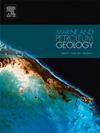Deciphering hydrocarbon evolution history of the Cambrian shales in tectonically complex basins: Constraints from calcite U-Pb dating and low-temperature thermochronology
IF 3.7
2区 地球科学
Q1 GEOSCIENCES, MULTIDISCIPLINARY
引用次数: 0
Abstract
Assessing hydrocarbon evolution of organic-rich shales in tectonically complex basins is critical for shale gas resource evaluation. A major obstacle is the difficulty in precisely constraining the timing of hydrocarbon migration and leakage events. Here, fluid inclusion microthermometry, calcite U-Pb and detrital zircon (U-Th)/He dating were integrated to reconstruct the hydrocarbon evolution history of the Cambrian organic-rich shales in the southeastern margin of the Upper Yangtze Platform. We assessed the dynamic evolution of shale gas content over time by methane isothermal adsorption coupled with geothermometry and geobarometry. The calcite veins yield U-Pb ages of 113.5–108.9 Ma (C1 calcite) and 65.5–65.2 Ma (C2 calcite), with fluid inclusion trapping temperatures of 186.2 °C and 74.8 °C, respectively. Detrital zircon (U-Th)/He dating indicate that the basin inversion started at the Middle Triassic (ca. 241 Ma), leading to a cooling in the shales. The onset of intense exhumation and folding deformation occurred at ca. 113Ma, which corresponds to the Yanshanian Orogeny. This tectonic deformation event triggered the opening of fractures (as indicated by the formation of the C1 calcite veins with ages of ca. 114–109 Ma), facilitating shale gas migration and leakage, with a shale gas loss of at least 0.75 cm3/g. These results demonstrate that combination of fluid inclusion and geochronological data can provide accurate geochronological constraints on shale gas migration and leakage associated with tectonic uplifts, which can be an effective approach to decipher hydrocarbon evolution history of shales in tectonically complex basins worldwide.
求助全文
约1分钟内获得全文
求助全文
来源期刊

Marine and Petroleum Geology
地学-地球科学综合
CiteScore
8.80
自引率
14.30%
发文量
475
审稿时长
63 days
期刊介绍:
Marine and Petroleum Geology is the pre-eminent international forum for the exchange of multidisciplinary concepts, interpretations and techniques for all concerned with marine and petroleum geology in industry, government and academia. Rapid bimonthly publication allows early communications of papers or short communications to the geoscience community.
Marine and Petroleum Geology is essential reading for geologists, geophysicists and explorationists in industry, government and academia working in the following areas: marine geology; basin analysis and evaluation; organic geochemistry; reserve/resource estimation; seismic stratigraphy; thermal models of basic evolution; sedimentary geology; continental margins; geophysical interpretation; structural geology/tectonics; formation evaluation techniques; well logging.
 求助内容:
求助内容: 应助结果提醒方式:
应助结果提醒方式:


